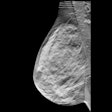Volpara Solutions is pointing to research presented this week on the use of its breast density software to generate reports on mammography radiation dose.
At this week's International Workshop on Breast Imaging (IWDM 2014) in Gifu City, Japan, researchers presented a study showing how to calculate patient-specific mean glandular dose (MGD) for mammography exams. This enables breast imagers to tune radiation dose to an individual woman's volumetric breast density, rather than assuming a breast density or making an estimate from compressed breast thickness.
Patient-specific MGD values were generated using VolparaDensity software to take data from the mammogram to estimate glandularity, the percentage of the breast that contains glandular tissue, and calculate density using a method presented by Dance et al. Researchers then compared the VolparaDensity values to those reported by the manufacturer for a database of 403 2D mammograms.
Agreement between the two techniques was good for dense breasts; however, MGD was underestimated in fatty breasts with manufacturer-based estimates. The researchers also compared 2D and 3D mammography and found that MGD calculated from tomosynthesis exams was higher than MGD from 2D mammograms for women with fattier breasts.
The findings suggest that the variation in dose estimates should be considered when evaluating which patients should get tomosynthesis versus 2D mammography, Volpara said.



















